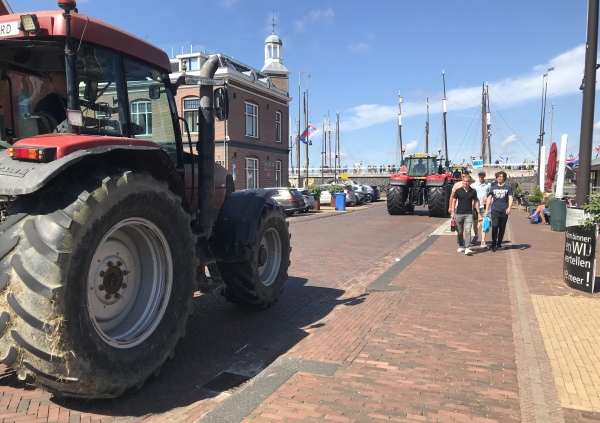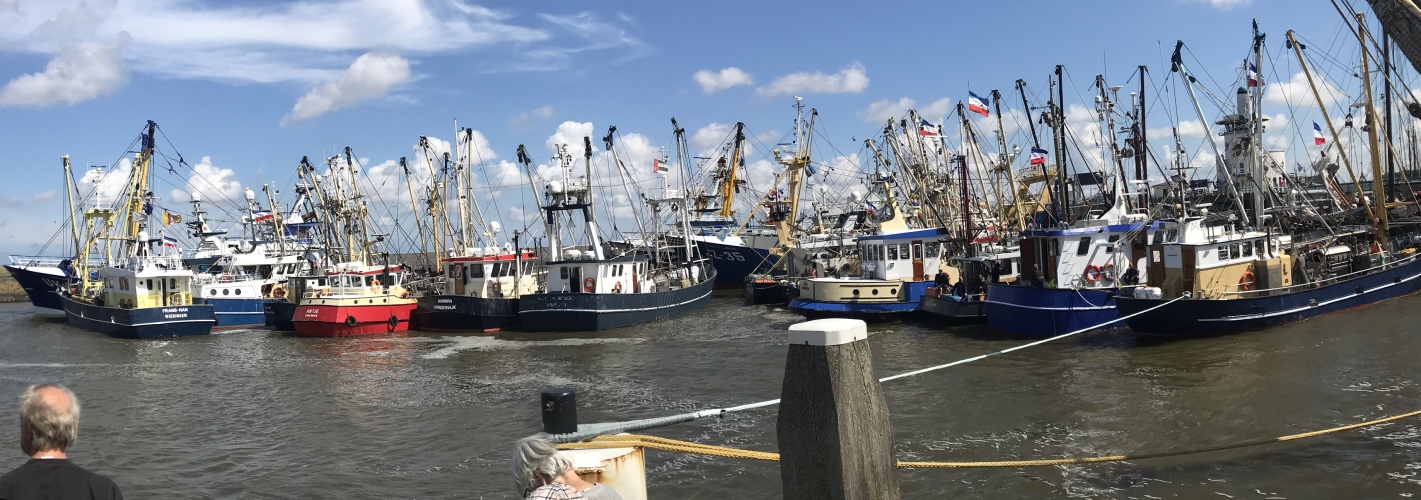I asked a policeman if he knew when the blockade would be lifted. He shrugged his shoulders, hinting at perhaps when the tide changed at noon. So, we had time to kill. I wandered along the harbour to seek out and eyeball the replica of the Willem Barentsz ship that was in the process of being built five years earlier by a group of enthusiastic old men, using mainly Danish oak. There were no designs, so the men evolved a design through what they could glean from old paintings and drawings, remains of old vessels deliberately sunk when the polders were being created, a section of the original old ship discovered by Russia and currently on display in a Russian museum, and the Batavia at Lelystad. Nearby had been an accompanying museum.
Willem Barentsz was born on the island of Terschelling off the Friesland coast of the Netherlands. He became the pupil of Petrus Plancius (Peter Platevoet), a theologian-cartographer whose sermons are often said to have been lessons in geography and astronomy.
In the late 16th century, the Dutch had an interest in the Orient, though at the time it seemed dangerous to contest the Portuguese monopoly of the route around the Cape of Good Hope. In 1595 Amsterdam merchants, undiscouraged by the English failure to find a Northeast Passage 40 years earlier, decided to resume the search. The Town Council of Amsterdam purchased and outfitted two small ships, captained by Jan Rijp and Jacob van Heemskerk, to search for the elusive channel under the command of Barentsz.
The ships departed on May 18th, 1596, and about three weeks later discovered Bear Island, south of the then-unknown Spitsbergen; they so named the island because of an encounter with a polar bear whose hide did not prove vulnerable to Dutch blunderbusses. Pressing northward, the Dutch ships came across the previously undiscovered uninhabited Spitsbergen islands on June 17th. During the rest of June the Dutch explored the western coast of the main island, thinking it a part of Greenland.
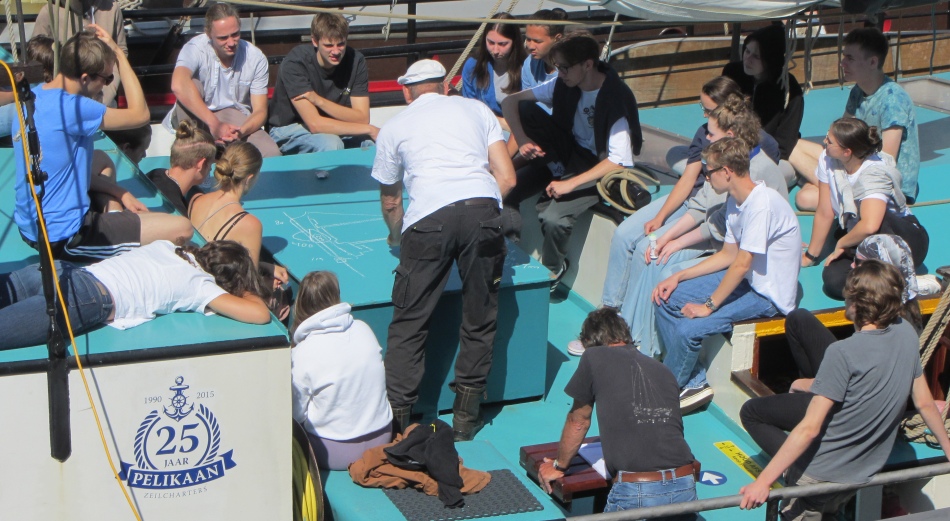
Lesson on Board a Tall Ship Trapped by the Blockade
|
The ships returned to Bear Island on 1st July. Here, anxieties over possible entrapment by ice resulted in a disagreement between Barentsz and Van Heemskerk on one side and Rijp on the other. They agreed to part ways, with Barentsz continuing northeast, while Rijp headed due north to resume exploration of Spitsbergen. Barentsz reached Novaya Zemlya on 17th July, previously discovered but not explored to its northern limit. Barentsz and Heemskerck rounded the northernmost point, naming it Hook of Desire, and sailed eastward, at first believing, from the open water encountered, that they had discovered the Northeast Passage. By November, however, the ice had grown thick and it finally imprisoned the ship. Barentsz and Heemskerck were 81�N at their highest latitude, beyond any point previously reached. Still close to Novaya Zemlya, they realised that they must build a solid shelter ashore in order to survive. They made one of logs and driftwood and moved into this 7.8x5.5m "Safe House" in October.
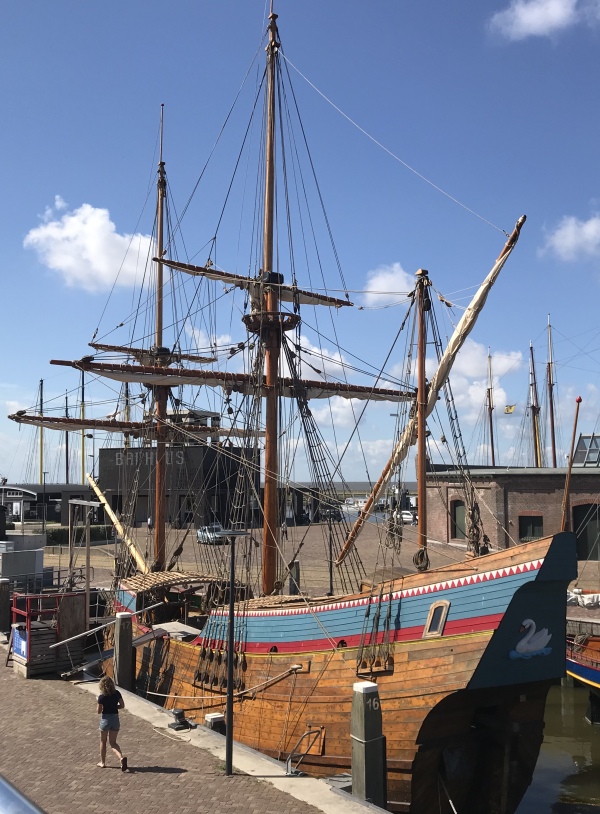
Replica of the Willem Barentsz Ship
|
Dealing with extreme cold, the crew realised that their socks would burn before their feet could even feel the warmth of a fire, and took to sleeping with warmed stones and cannonballs. In addition, they used the merchant fabrics aboard the ship to make additional blankets and clothing. The ship bore salted beef, butter, cheese, bread, barley, peas, beans, groats, flour, oil, vinegar, mustard, salt, beer, wine, brandy, hardtack, smoked bacon, ham and fish. Much of the beer froze, bursting the casks. Proving successful at hunting, the group caught 26 Arctic foxes in primitive traps, as well as killing a number of polar bears. By 8th November, Gerrit de Veer, the ships carpenter who kept a diary, reported a shortage of beer and bread, with wine being rationed four days later. In January 1597, De Veer became the first person to witness and record the atmospheric anomaly known as the Novaya Zemlya effect.
Conditions then deteriorated; the firewood gave out, and the ship was crushed by ice. The men began to construct two small boats. Scurvy had been present for months, and one of the worst sufferers was Barentsz. He left on 13th June with the rest as they slowly worked down Novaya Zemlya, but he grew so weak that he could take no part in manipulating the craft. Barentsz died at sea on 20th June 1597, soon after asking Gerrit de Veer, chronicler of the expedition, to lift him up for a final look at Novaya Zemlya. Heemskerck and the other survivors reached the Kola Peninsula after seven more weeks, where they were rescued by a Russian merchant vessel, and by that time only 12 crewmen remained. They heard of a Dutch ship not far off, and a messenger was sent to ascertain whether it would rescue them. By pure coincidence the Dutch vessel was captained by Rijp, who had returned to Holland and come back for trade. Ultimately, they did not reach Amsterdam until 1st November.
In the 1870s European ships visited "Safe House" and found it partially caved in by snow. Objects left there by the Dutch explorers are in the Rijksmuseum in Amsterdam.
At noon, after an exceptionally long wailing session from the trawlers and tractors, the trawlers started tom peel off one by one. I informed Rex and quickly marched back to get
Duonita underway. We eased our way out of the marina and entered into the Harinxmakanaal and started gilling with a few other boats waiting for the sea lock to open. Once it did open, a German motor boat shot into the lock, and as we headed towards the lock, a boat in front of us turned sideways as if his intentions were to ram a moored tall ship. His intentions were totally unclear, and we reckoned he had no idea what he was doing. Admiral Davenport smartly swerved around the back of him. The boat behind us hadn't noticed the rogue sailor and had to perform an emergency stop to avoid ramming into him. We never did learn what happened to captain calamity but he certainly didn't come through the lock in the end. Another yacht entering the lock behind us had to be fended off as he nearly hit our stern. Rex naturally ended up laughing and chatting with the skipper.
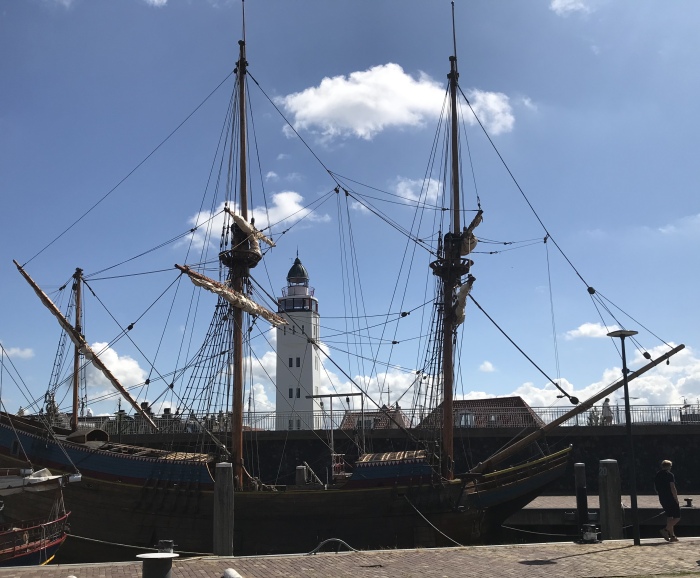
Replica of the Willem Barentsz Ship
|
There was much cause for celebration as we finally left the lock, even more so since we were the first boat out. That must have upset the Germans and Dutch. However, they made their point by shooting past us at high speed once we were all clear of the lock. But all the bravado was dismissed by a loud blast from a large and quick moving catamaran carrying fully laden trucks to one of the islands. He was coming through and he was not taking any prisoners.
We once again headed out into the Waddenzee. In a Force 5 we pounded our way down to the lock at Kornwerderzand, sharing the narrow channel with other yachts, barges, a trawler and a couple of 35 knot police RIBs. Rex's tea cup got smashed on route, and for the second time on the trip, his ash tray with at least twenty cigarette buts ended up all over the floor.
On reaching the basin just before the massive swing bridge at the Afsluitdijk, a Dutch sailor shouted over to us that we would have to wait for an hour for it to open. We thanked the chap, and another bloke from a tall ship helped us get a rope from the bow around a bollard, allowing us to just hang off the bollard in the fresh breeze. A number of yachts, tall ships and a large barge waited patiently. Then a very large, expensive gin palace of a motorboat arrived at the locks, last to arrive, and edged its way to the front.
Suddenly a shout rang out from the Dutch sailor we had spoken to before, "They are going to open the bridge early." Within ten minutes we had all passed the swing bridge, and were sitting in another basin waiting for the lock to open. The yacht lock opened and a couple of tall ships entered. Much to Rex's dismay, the large motorboat forged ahead, and once in the lock, it had to crawl along inside the lock since his beam was almost as wide as the lock. This took an age; a livid Rex was bouncing up and down cursing in Dutch and Italian. Once the large motorboat was in, nothing else could get in, so we were all forced back into the basin, all yachts reversing with much cursing going on.
We all gilled about, and then the large commercial traffic lock opened and two tall ships entered. There was enough room for yachts to squeeze up beside the tall ships, but because the signals at the entrance to the lock were lit as red plus green, none of the yachts would enter. As soon as they all turned green we all slowly , entered, squeezing between the lock side and the tall ships.
The school children on the adjacent tall ship started talking to the Rear Admiral who was out in the cockpit. "How much did your boat cost?" the enquired. "About 35k Euros," he answered. The man in charge of them (teacher or leader) asked, "Was that new?" "No, I bought it second-hand," replied Rex. The conversation carried on between Rex and "leader", and when Rex asked where their next port of call was, the "leader" looked blank and shook his head. The pupils answered, "Stavoren." Rex was not impressed with the "leader" at all.
The seamanship of the skipper of the tall ship to the front of us impressed me. He had no bow thruster, but expertly sprung off the lock side and powered out of the lock.
Once through the lock we headed straight to Hindeloopen. I had booked ahead for a berth for the night, requesting a 3.5m wide berth, actually 0.2m wider than
Duonita's beam since the Dutch have a habit of putting us into narrow berths. On arrival, we tried to enter the berth allocated to us and got ourselves wedged between the two aft posts. A couple of German fellows on a nearby boat saw our predicament and pointed to wider berths opposite. We managed to extract ourselves and berthed in a larger box. Perhaps we should say our beam is 4m piped up Rex.
In the evening we returned to De Boekanier for a beer, joking with the barman that we would not forget to pay this time. As for food, almost all the restaurants were closed (Monday), but we found the Restaurant logement De Hinde next door to De Boekanier open. Yes, they could squeeze us in. It was an upmarket restaurant and the food was excellent. I watched a German couple next to us feeding each other food. The chap knocked his glasses onto the floor. We pointed this out to him. "Yes, I know!" was his curt response, and he just ignored his glasses. I picked them up and put them on his table before they got trampled on. He ignored me and continued to feed the woman - they weren't exactly teenagers! Another table had three guys sitting at it. One of them was determined to eat all the chips on the table. I wonder what they made of us two scruffs.
The male waiter who served the dishes was a bit zany, his stock phrase was, "Shit happens." The waitress spoke excellent English, as well as German. It turned out she had worked in California for thirty years.
We ate well that night, and Rex and I returned to the boat rather tipsy. It had been a long day.
